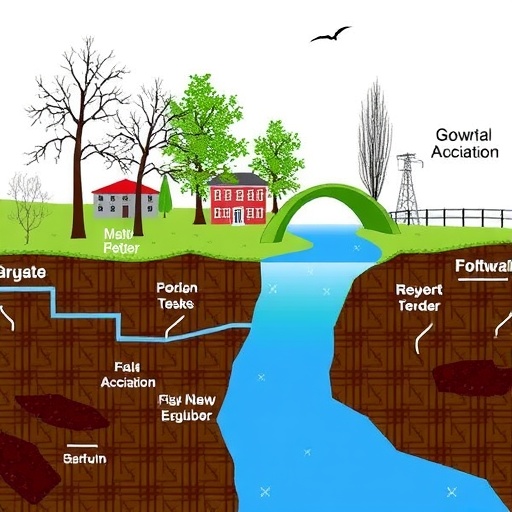The interplay of climate change and urbanization poses significant challenges to natural groundwater recharge, especially in densely populated urban settings. This intricate relationship has been the subject of extensive research, particularly through combining advanced modeling techniques. A recent study spearheaded by Ghezali and Boukhemacha sheds light on this pressing issue, utilizing a combination of the Conceptual Architecture-Artificial Neural Networks (CA-ANN), Coupled Model Intercomparison Project Phase 6 (CMIP6) General Model (GM), and the Soil Conservation Service Curve Number (SCS-CN) methodologies. This multidimensional approach aims to evaluate the future impacts of climate change and urbanization on groundwater recharge potential at a city scale.
The significance of groundwater as a crucial component of the hydrological cycle cannot be overstated. It not only supports human needs but also sustains ecological systems. However, this vital resource is increasingly threatened by urbanization, which alters the land surface and diminishes the natural processes of recharge. The research presented in Ghezali et al.’s work explores these dynamics with precision, providing essential insights into how urban expansion and climate variability can shape groundwater recharge patterns in the decades to come.
One of the study’s primary tools, the CA-ANN model, is particularly noteworthy for its ability to synthesize complex datasets and identify non-linear relationships. By employing this method, the researchers can forecast how changing land use patterns and climate conditions will influence the hydrological responses in urban areas. Additionally, integrating CMIP6 GM into the modeling framework allows for a more nuanced understanding of global climate trends and their potential local implications. This collaborative modeling strategy not only enhances prediction accuracy but also adds robustness to the findings, making them more relevant for urban planners and policymakers.
Urbanization leads to increased impervious surfaces such as roads and buildings, which significantly hinder natural water infiltration and reduce groundwater recharge. This phenomenon is brilliantly captured in the study as it examines the heightened runoff generated by urban expansion in conjunction with climate variability. In essence, the research highlights a critical feedback loop: as urban areas grow, their ability to naturally replenish groundwater is compromised, which exacerbates the effects of climate change.
Moreover, the SCS-CN method utilized in the study provides a practical approach to quantifying potential groundwater recharge. This method accounts for various land use types and soil conditions, yielding insights into the recharge rates across different urban landscapes. By intertwining these methodologies, Ghezali and Boukhemacha paint a comprehensive picture of how urbanization combined with climate change could alter the natural hydrological balance in city settings. This is particularly important for water resource management and urban planning, making the results of this research vital for future urban developments.
As the world stands on the brink of unprecedented climatic upheaval, understanding groundwater recharge dynamics becomes essential. The findings from this research offer valuable predictions that can help mitigate future risks associated with water scarcity in urban regions. By providing decision-makers with reliable data, it encourages the implementation of strategies targeted at preserving and enhancing groundwater replenishment capabilities.
In the context of policymakers, this study serves as a crucial alert regarding the impending water crises multilayered in urban environments. Its findings advocate for more sustainable urban planning practices that prioritize green infrastructure and the necessity of preserving natural landscapes. This is pivotal in ensuring that cities can sustain their populations without compromising their water resources.
The researchers assert that adaptive management strategies, informed by advanced modeling techniques, could shift the paradigm in how cities confront water management challenges. Engagement with various stakeholders in the planning and implementation phases of urban development is crucial in facilitating changes that can ultimately lead to more resilient urban water systems.
In conclusion, Ghezali and Boukhemacha’s study presents a compelling integration of sophisticated modeling tools to address the critical issue of potential natural groundwater recharge in the context of climate change and urbanization. As urban areas continue to expand, the necessity for thorough research in hydrological impacts grows ever more urgent. Through innovative methodologies and collaborative approaches, the study not only contributes to the academic understanding of urban hydrology but also equips urban planners and policymakers with the tools needed to navigate the complexities of water resource management in a changing world.
The importance of this research cannot be overstated, as urban water systems are increasingly becoming strained under the pressures of climate change and human development. By equipping decision-makers with empirical data on groundwater recharge patterns, Ghezali and Boukhemacha take a significant step toward ensuring sustainable urban futures. Their innovative approach serves as a model for future research, emphasizing the importance of integrating various methodologies to tackle real-world problems.
As more cities grapple with the dual pressures of climate adaptation and sustainable growth, the research presented is a beacon for future studies aimed at safeguarding groundwater resources against looming threats. The challenge may be daunting, but proactive approaches grounded in solid data and predictive modeling can bring about innovative solutions to one of the most pressing issues of our time: the preservation of natural resources in an ever-evolving landscape.
In essence, the research illustrates the essential connection between water resources and urban planning, highlighting the critical need for evidence-based strategies in shaping the future of urban environments. As we look forward to the upcoming decades, studies like these will be invaluable in guiding how cities can adapt and thrive in an era marked by change and uncertainty.
Subject of Research: The impacts of climate change and urbanization on potential natural groundwater recharge.
Article Title: Combined CA-ANN, CMIP6 GM and SCS-CN modeling of future impacts of climate change and urbanization on potential natural groundwater recharge at city scale.
Article References:
Ghezali, S., Boukhemacha, M.A. Combined CA-ANN, CMIP6 GM and SCS-CN modeling of future impacts of climate change and urbanization on potential natural groundwater recharge at city scale.
Environ Monit Assess 197, 1282 (2025). https://doi.org/10.1007/s10661-025-14743-7
Image Credits: AI Generated
DOI: 10.1007/s10661-025-14743-7
Keywords: Groundwater recharge, climate change, urbanization, CA-ANN, CMIP6, SCS-CN, hydrological modeling, urban planning.




